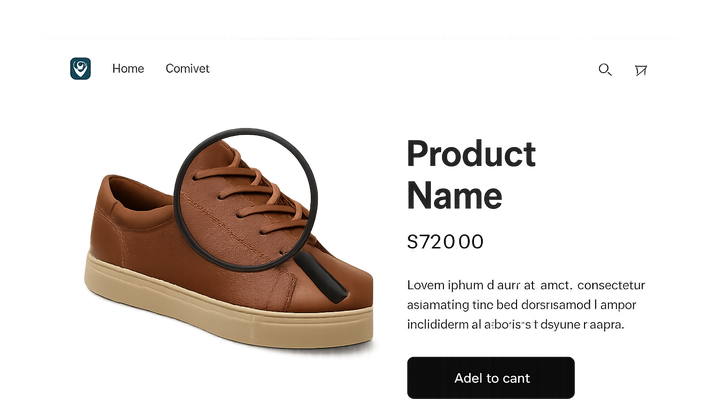Published on 2025-06-29T21:37:08Z
What is the Product Zoom Feature? Examples and Best Practices
The Product Zoom Feature is an interactive UI component on e-commerce and product-focused websites that allows users to magnify product images for a closer look at details, textures, and features. It typically activates on hover, click, or tap, offering a magnified view either inline or in a separate lightbox. By enabling customers to examine products more closely, it addresses common usability challenges like uncertainty around product quality or specifications. In the context of CRO (Conversion Rate Optimization), UX (User Experience), and SEO (Search Engine Optimization), a well-implemented zoom feature can boost engagement, reduce bounce rates, and support improved on-page metrics. Accessibility and performance considerations—such as keyboard navigation support and efficient image loading—are essential to ensure the feature enhances overall site experience without compromising load times or usability.
Product zoom feature
Interactive magnification tool that enlarges product images for improved UX, SEO signals, and conversion rate optimization.
Definition and Purpose
This section explores what the Product Zoom Feature is and why it’s used on e-commerce and product-centric websites.
-
Core functionality
Enables users to magnify product images via hover or click, revealing fine details such as texture, stitching, or labeling.
- Hover-to-zoom:
Magnification occurs when the cursor hovers over the image region, often following the cursor movement.
- Click-to-zoom:
Users click or tap the image to open a larger view in place or in a lightbox overlay.
- Hover-to-zoom:
-
Primary use cases
Commonly used in apparel, electronics, and home goods sites where product details influence purchase decisions.
Why It Matters for CRO, UX, and SEO
Implementing a robust Product Zoom Feature can have significant impacts on conversions, user satisfaction, and search performance.
-
Boosting conversion rates
By reducing uncertainty and answering visual questions, zoom features can increase add-to-cart rates.
-
Enhancing user engagement
Interactive elements keep visitors on the page longer, reducing bounce rates and signaling quality to search engines.
-
Improving seo signals
Longer dwell time and lower bounce rates contribute positively to SEO; optimized images can also load quickly for mobile search.
Examples in Practice
Real-world examples showcase how the Product Zoom Feature is applied on popular platforms and how prevue.me identifies optimization opportunities.
-
Prevue.me critiques
prevue.me analyzes product pages to flag missing or suboptimal zoom implementations, recommending improvements for maximum lead generation.
-
Shopify’s built-in zoom
Many Shopify themes include hover zoom out of the box, but theme performance and mobile behavior can vary.
-
Custom solutions on magento
Extensions like Magic Zoom Plus offer deep customization but require performance testing to avoid slowing page speeds.
Implementation Best Practices
Key guidelines to ensure your Product Zoom Feature is performant, accessible, and effective.
-
Optimize image assets
Serve high-resolution images with appropriate compression formats (e.g., WebP) and use lazy loading to improve load times.
-
Ensure mobile responsiveness
Adapt zoom interactions for touch devices, using pinch-to-zoom or tap triggers instead of hover-only.
-
Accessibility considerations
Implement keyboard navigation, descriptive alt text, and ARIA roles to support users with disabilities.
- Keyboard navigation:
Allow focus and activation of zoom via keyboard (e.g., Enter or Space keys).
- Alt text guidance:
Include concise, descriptive alt text for the base image to maintain context when zoom is not available.
- Aria roles:
Use appropriate ARIA attributes to announce zoom controls to assistive technologies.
- Keyboard navigation:
-
Code example
<img src="product-thumb.jpg" data-zoom-image="product-large.jpg" alt="Product Name" class="zoom" /> <script> $('.zoom').zoom({ magnify: 2 }); </script>
Testing and Optimization
Regular testing ensures your zoom feature delivers value without hindering performance.
-
A/b testing variants
Compare different zoom triggers, magnification levels, and UI placements to identify what drives conversions.
-
Heatmap analysis
Track where users hover and click to ensure the zoom area aligns with user behavior.
-
Performance monitoring
Use tools like Lighthouse to measure the impact of zoom scripts and image sizes on page load speed.
